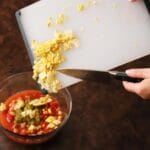Replace Your Plastic Cutting Boards
Equipment
- 1 Hot water
- 2 Dishwashing liquid or mild soap
- 3 Dish brush or sponge
- 4 Paper towels or a clean kitchen towel
- 5 Optional: Baking soda, white vinegar, or bleach for sanitizing (if used for raw meat, fish, or poultry)
Materials
- Step 1: Pre-Rinse Before you start washing, give the plastic cutting board a quick pre-rinse under running hot water to remove loose food particles and debris.
- Step 2: Apply Soap Apply a small amount of dishwashing liquid or mild soap onto the surface of the cutting board. Ensure that the entire surface is covered.
- Step 3: Scrub Use a dish brush, sponge, or scrubbing pad to scrub the cutting board's surface thoroughly. Pay attention to any visible stains, residue, or grooves. Scrub all areas, including the edges and corners.
- Step 4: Rinse Rinse the cutting board under hot running water. Make sure to rinse away all the soap residue until the water runs clear.
- Step 5: Optional Sanitization (if needed) If the cutting board has been in contact with raw meat, fish, or poultry, it's advisable to sanitize it to eliminate any lingering bacteria. You have a few options:Bleach Solution: Mix 1 tablespoon of unscented liquid chlorine bleach with 1 gallon of water. Apply this solution to the cutting board's surface and let it sit for a few minutes. Then, rinse thoroughly and allow it to air dry.Vinegar and Baking Soda: Sprinkle baking soda over the cutting board, followed by a generous application of white vinegar. Let the mixture fizz and sit for a few minutes. Scrub the board once more with a brush or sponge, rinse, and dry.
- Step 6: Dry After washing and, if necessary, sanitizing, use paper towels or a clean kitchen towel to pat the cutting board dry. Ensure it is completely dry before storing it to prevent mold growth.
Instructions
- Tips:Avoid using abrasive scouring pads or steel wool, as they can damage the plastic surface.Do not soak plastic cutting boards for extended periods, as they can absorb water and become warped.Consider having separate cutting boards for different types of food (meat, vegetables, fruits) to prevent cross-contamination.
